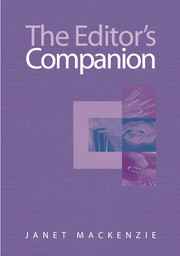Book contents
- Frontmatter
- Contents
- List of illustrations
- Preface
- 1 The editor in context
- 2 The publishing process
- 3 Management and liaison
- 4 Substance and structure
- 5 Language
- 6 Illustrations and tables
- 7 Completeness and consistency
- 8 Proofs
- 9 Editing methods
- 10 Working with documents and files
- 11 Freelance editing
- Appendix: Australian Standards for Editing Practice
- Notes
- Select bibliography
- Index
7 - Completeness and consistency
Published online by Cambridge University Press: 05 June 2012
- Frontmatter
- Contents
- List of illustrations
- Preface
- 1 The editor in context
- 2 The publishing process
- 3 Management and liaison
- 4 Substance and structure
- 5 Language
- 6 Illustrations and tables
- 7 Completeness and consistency
- 8 Proofs
- 9 Editing methods
- 10 Working with documents and files
- 11 Freelance editing
- Appendix: Australian Standards for Editing Practice
- Notes
- Select bibliography
- Index
Summary
Completeness and consistency make a publication fit for purpose, to use the terminology of the Trade Practices Act. Readers feel cheated when they are referred to a non-existent illustration or are unable to follow information to its source. The editor is responsible for overseeing the integrity of a publication, as Chapters 13 and 14 of the Style Manual explain. Of course completeness and consistency apply to all parts of the publication, but here we survey the non-text items; proofs and quality control are discussed in the next chapter.
Eliminate meaningless variation
A large part of copyediting consists of imposing consistency on the linguistic and visual elements of a publication. The rationale for this is that meaningless variation distracts the reader. He may not consciously notice, for instance, that enquiry is sometimes spelt inquiry, but too many such variations will disturb him at a subliminal level and impede his absorption of the meaning.
The editor establishes an appropriate style, or follows house style, and ensures it is applied consistently throughout. As you gain experience you will do this routinely, knowing which expressions are likely to give trouble. You must ensure consistency not only in spelling but in all the matters listed in Standard E–the expression of numbers, the style and wording of the headings and captions, the layout of lists, quotations and tables, and so on (see Appendix).
Variations in terminology will confuse the reader more than inconsistent capitals and hyphens.
- Type
- Chapter
- Information
- The Editor's Companion , pp. 108 - 122Publisher: Cambridge University PressPrint publication year: 2004



